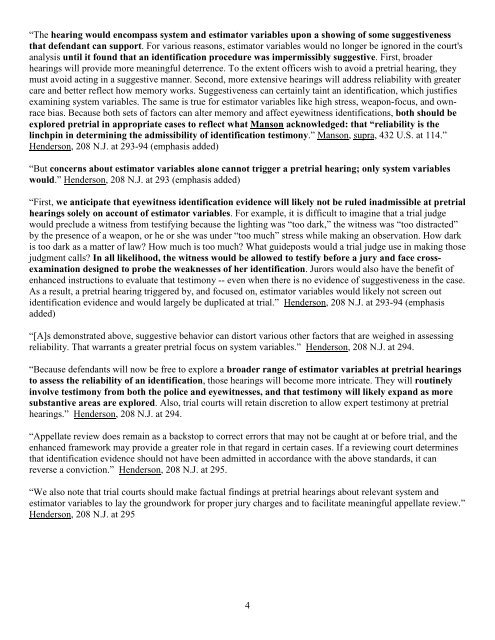State v. Henderson and the New Model Jury Charges - New Jersey ...
State v. Henderson and the New Model Jury Charges - New Jersey ...
State v. Henderson and the New Model Jury Charges - New Jersey ...
You also want an ePaper? Increase the reach of your titles
YUMPU automatically turns print PDFs into web optimized ePapers that Google loves.
“The hearing would encompass system <strong>and</strong> estimator variables upon a showing of some suggestiveness<br />
that defendant can support. For various reasons, estimator variables would no longer be ignored in <strong>the</strong> court's<br />
analysis until it found that an identification procedure was impermissibly suggestive. First, broader<br />
hearings will provide more meaningful deterrence. To <strong>the</strong> extent officers wish to avoid a pretrial hearing, <strong>the</strong>y<br />
must avoid acting in a suggestive manner. Second, more extensive hearings will address reliability with greater<br />
care <strong>and</strong> better reflect how memory works. Suggestiveness can certainly taint an identification, which justifies<br />
examining system variables. The same is true for estimator variables like high stress, weapon-focus, <strong>and</strong> ownrace<br />
bias. Because both sets of factors can alter memory <strong>and</strong> affect eyewitness identifications, both should be<br />
explored pretrial in appropriate cases to reflect what Manson acknowledged: that “reliability is <strong>the</strong><br />
linchpin in determining <strong>the</strong> admissibility of identification testimony.” Manson, supra, 432 U.S. at 114.”<br />
<strong>Henderson</strong>, 208 N.J. at 293-94 (emphasis added)<br />
“But concerns about estimator variables alone cannot trigger a pretrial hearing; only system variables<br />
would.” <strong>Henderson</strong>, 208 N.J. at 293 (emphasis added)<br />
“First, we anticipate that eyewitness identification evidence will likely not be ruled inadmissible at pretrial<br />
hearings solely on account of estimator variables. For example, it is difficult to imagine that a trial judge<br />
would preclude a witness from testifying because <strong>the</strong> lighting was “too dark,” <strong>the</strong> witness was “too distracted”<br />
by <strong>the</strong> presence of a weapon, or he or she was under “too much” stress while making an observation. How dark<br />
is too dark as a matter of law? How much is too much? What guideposts would a trial judge use in making those<br />
judgment calls? In all likelihood, <strong>the</strong> witness would be allowed to testify before a jury <strong>and</strong> face crossexamination<br />
designed to probe <strong>the</strong> weaknesses of her identification. Jurors would also have <strong>the</strong> benefit of<br />
enhanced instructions to evaluate that testimony -- even when <strong>the</strong>re is no evidence of suggestiveness in <strong>the</strong> case.<br />
As a result, a pretrial hearing triggered by, <strong>and</strong> focused on, estimator variables would likely not screen out<br />
identification evidence <strong>and</strong> would largely be duplicated at trial.” <strong>Henderson</strong>, 208 N.J. at 293-94 (emphasis<br />
added)<br />
“[A]s demonstrated above, suggestive behavior can distort various o<strong>the</strong>r factors that are weighed in assessing<br />
reliability. That warrants a greater pretrial focus on system variables.” <strong>Henderson</strong>, 208 N.J. at 294.<br />
“Because defendants will now be free to explore a broader range of estimator variables at pretrial hearings<br />
to assess <strong>the</strong> reliability of an identification, those hearings will become more intricate. They will routinely<br />
involve testimony from both <strong>the</strong> police <strong>and</strong> eyewitnesses, <strong>and</strong> that testimony will likely exp<strong>and</strong> as more<br />
substantive areas are explored. Also, trial courts will retain discretion to allow expert testimony at pretrial<br />
hearings.” <strong>Henderson</strong>, 208 N.J. at 294.<br />
“Appellate review does remain as a backstop to correct errors that may not be caught at or before trial, <strong>and</strong> <strong>the</strong><br />
enhanced framework may provide a greater role in that regard in certain cases. If a reviewing court determines<br />
that identification evidence should not have been admitted in accordance with <strong>the</strong> above st<strong>and</strong>ards, it can<br />
reverse a conviction.” <strong>Henderson</strong>, 208 N.J. at 295.<br />
“We also note that trial courts should make factual findings at pretrial hearings about relevant system <strong>and</strong><br />
estimator variables to lay <strong>the</strong> groundwork for proper jury charges <strong>and</strong> to facilitate meaningful appellate review.”<br />
<strong>Henderson</strong>, 208 N.J. at 295<br />
4
















